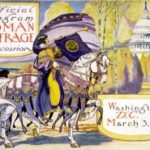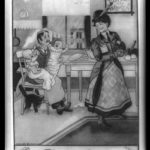On August 18, 1920, women won the right to vote with the ratification of the 19th Amendment. In this lesson, students will hear suffragists Susan B. Anthony, Sojourner Truth and Alice Paul, as portrayed by interpreters from the American Historical Theatre, talk about their experiences as activists.
Suffragists and Their Tactics
19th Amendment: Women’s Right to Vote
In this learning module, students will trace the roots of the women’s rights movement, from early reform efforts in the 1800s to the ultimate decision to pursue voting rights. This unit explores the constitutional arguments over women’s suffrage, the historical context of the fight for suffrage over 70 years, and the tactics suffragists used to persuade state legislatures and the national government to recognize voting rights for women.
The Seneca Falls Convention and the Declaration of Sentiments
The Seneca Falls Convention, held in Seneca Falls, New York, on July 19 to July 20, 1848, was the first women’s rights convention held in the United States. At that convention, the Declaration of Sentiments was written that outlined demands for women’s equality. This lesson uses video clips to have students understand the important people and events that led to the Declaration of Sentiments and then apply the text of the Declaration to today.
Extending Suffrage to Women
In this activity, students will analyze documents pertaining to the women’s suffrage movement as it intensified following passage of the 15th Amendment, which guaranteed the right to vote for African American males. Documents were chosen to call attention to the struggle’s length, the movement’s techniques, and the variety of arguments for and against giving women the vote.
Who Were the Foremothers of the Women’s Suffrage and Equality Movements?
This lesson looks at the women’s suffrage movement that grew out of the failing of the Continental Congress by “remembering the ladies” who are too often overlooked when teaching about the “foremothers” of the movements for suffrage and women’s equality in U.S. history. Grounded in the critical inquiry question “Who’s missing?” and in the interest of bringing more perspectives to whom the suffrage movement included, this resource will help to ensure that students learn about some of the lesser-known activists who, like Elizabeth Cady Stanton, Lucretia Mott, and Susan B. Anthony, participated in the formative years of the women’s rights movement.
Modern Women Persuading Modern Men: The Nineteenth Amendment and the Movement for Woman Suffrage, 1916–1920
In “Modern Women Persuading Modern Men: The Nineteenth Amendment Completes the Movement for Woman Suffrage,” Jonathan Soffer explains how Carrie Chapman Catt’s “Winning Plan” achieved what over half a century of struggle had failed to achieve: women’s full political citizenship. Free registration for students and teachers required to access resource.
Sisters of Suffrage: British and American Women Fight for the Vote

The dominant narrative of the entire women’s suffrage movement begins and ends with the United States and Britain. Hundreds of thousands of women petitioned, canvassed, lobbied, demonstrated, engaged in mass civil disobedience, went to jail, and engaged in hunger strikes in a seventy-five-year ongoing political and social struggle for the right to vote. Free registration for students and teachers required to access resource.
